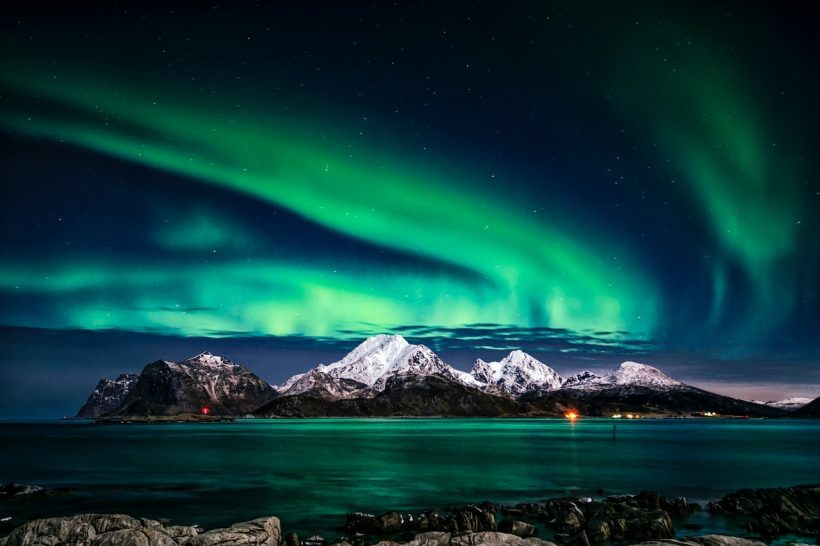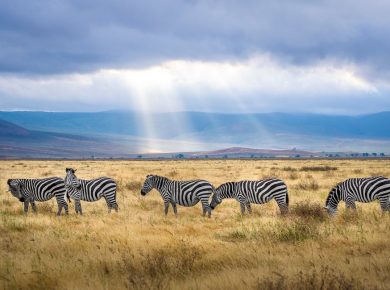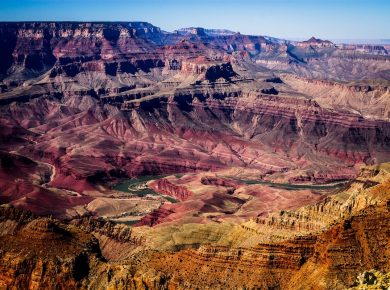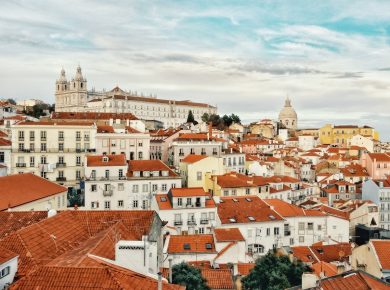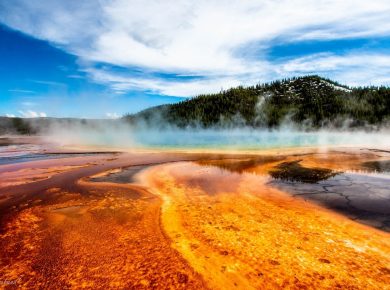Norway has everything you could ever want from a Scandinavian adventure. From cruises to incredible nature and city life, it’s easy to get lost in the beauty of this Nordic gem.
Every summer, outdoor fans gather in the Norwegian wilderness to traverse jagged, rocky peaks and stand atop the deep fjords. Summertime in cities like Oslo equals lots of outdoor events like Øya music festival, but also big crowds!
It’s also a land of extremes. On one hand, summers see mildly warm temperatures with over 22 hours of sunshine! On the other, Norwegian winters, though maybe pleasant to look at, are brutal! Temperatures barely rise above freezing and the sun rises and sets within six hours.
The best months to visit Norway are during the shoulder season months of May, June, July and August when the weather is warmer ideal for hiking, kayaking, cycling and berry picking.
Does that make the winter a no-go time for Norway? Of course not! It all depends on what kind of tourist you are. Avid hikers might miss out when visiting in the cold season, but they might get to see the northern lights. Summer tourists are unlikely to get this experience!
Moreover, when the fair-weather travelers pack up and leave for the cold season, the cross-country skiers come out to play. Each season has something unique to offer. This article assesses the average weather and tourist season trends to determine the best month to visit Norway for good weather and low prices.
To do this, we will look at state-wide weather patterns based on three cities: Capital city Oslo in the southeast, Bergen among the western fjords, and Tromsø in the north. Furthermore, we analyze tourism trends in these areas to determine how traffic reflects in pricing.
Table of Contents
Average Temperature In Norway
Norway gets all four seasons. Some are felt more strongly than others. Particularly in the summer, geography plays a big role in how warm you’ll be.
Summers aren’t terribly hot, but Oslo gets fairly warm in July with average high temperatures pushing 71°F and lows of 54°F. Bergen is considerably cooler with peak highs of 64°F and lows of 52°F in August. Just north of the Arctic Circle, Tromsø doesn’t get much shorts-and-T-shirt-friendly weather. It warms up to a peak high of 59°F in July with lows of 48°F at night.
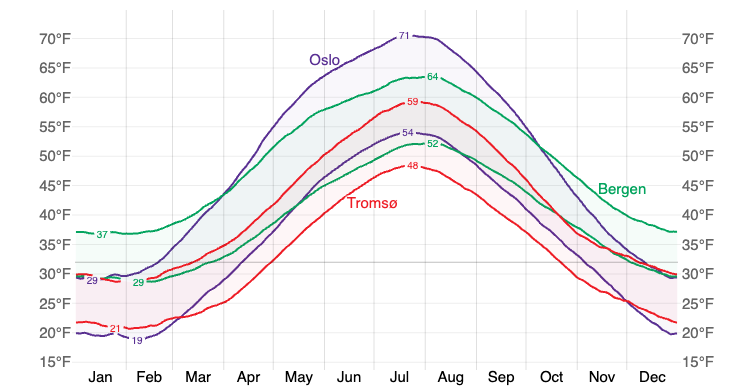
Winters are COLD! Only Bergen has high temperatures above freezing with 37°F in January and February. At night, however, it drops to the upper 20s. This is the high for Oslo at the same time. The capital maxes out around 29°F and drops to 20°F at night.
Tromsø, though located at the opposite end of the country from Oslo, has about the same winter temperatures. Thanks to the powerful Gulf Stream current from the Atlantic, warmer water pushes through the fjords near the city, making it one of the warmest areas in the Arctic Circle!
Spring and autumn are both mild for Norway. Each city warms up and cools off at a similar rate and the conditions are friendly to most kinds of tourism.
Daily Chance Of Precipitation In Norway
The cities discussed in this article get a steady amount of precipitation throughout the year. Though your vacation isn’t likely to be rained out or snowed in altogether, it’s wise to pack accordingly.
For most of the year, Oslo’s chance of precipitation rests between 25% and 35%. The amount of actual rainfall is low, though, peaking at 3.4 inches of total rainfall in August. An umbrella or raincoat should help you overcome this minor obstacle. However, expect almost 9 inches of snowfall in January!
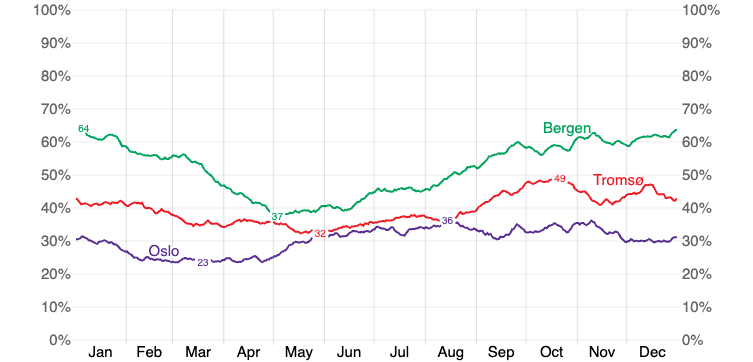
Bergen is the wettest city but has a drier period during the summer where the chance of precipitation lingers around 40% but the total rainfall is very low. Winters can get nasty here, as rain is more common than snow. From November through January, the city gets over 9 inches of rain a month. This combined with the cold temps can make your time there hard to enjoy.
Tromsø is in between. Like Oslo, it has a steady chance of precipitation year-round, but it’s slightly higher than in the capital. There’s at least a 32% chance, but it grows to 49% in October. Rainfall is minimal. However, the city can receive up to 17.5 inches of snow in mid-January! You’ll need some heavy-duty snow gear if considering a visit at this time.
Humidity Comfort Levels In Norway
With all the monstrous weather conditions found in Norway, let’s put your mind at ease with one less problem: humidity! There is a zero percent chance of humid conditions in the three cities year-round. Instead, focus your attention on staying warm!
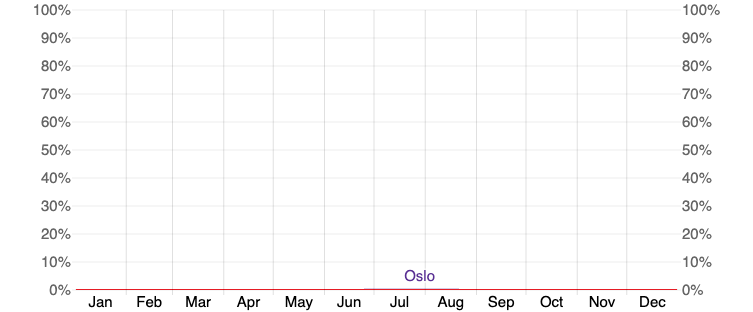
If visiting in the summer, you can enjoy the extra-long days without fear of that uncomfortably thick air beating down on you.
Best Time Of Year To Visit Norway For Great Weather
Norway’s climate makes it an atypical destination for some types of tourism. Sightseeing in the city is limited to certain parts of the year due to extreme winters. While heat and humidity are non-issues, chances are you will encounter rain and seriously cold temperatures. When is the best time to visit to keep as warm and dry as possible? Though challenging, it’s not impossible!
There are two factors used to decide the best months for weather called the “tourist score” and the “beach/pool score,” respectively. The first is used to determine how pleasurable outdoor activities like sightseeing tours are in a given month. Clear skies and temperatures between 65°F and 80°F are the criteria here.
With temperatures hardly entering this bracket, it’s no surprise that Norway’s tourist score is low. For sightseeing and walking tours, July is the best time for all three cities. Oslo has the best conditions with a tourist score of 6.4. Though not as hot as Madrid or Rome, you’ll neither freeze nor burn alive spending a whole summer’s day outdoors.
Bergen is next in line with 4.6. Though hardly ideal, it’s still a huge attraction and tourists don’t seem to mind bundling up to see the charming little houses that line the fjord.
Tromsø is in last place. A tourist score of 3.4 makes it a tough sell for casual travelers. Its biggest attractions make it a suitable winter destination, however. Many people visit the northern city for dog sledding, whale watching, and catching the Aurora Borealis, all of which are wintertime activities.
As expected, the beach/pool score is extremely low. There are few times or places in Norway where swimming outdoors would be a comfortable activity. Norwegian cruises, on the other hand, are a good alternative. Providing comfort and a plethora of leisure activities, they usually have heated pools!
Best Time Of Year To Visit Norway For Low Prices
After investing in warm clothes, you’ll want the rest of your trip to Norway to be as affordable as possible. This may prove challenging, as Scandinavian economies are notorious for being tough on foreigners’ wallets. Something as simple as a lager beer might run you $9. However, travel hacks for cheaply getting to and sleeping in Norway are plentiful! You just need to know where to look.
Thanks to its position as a frequent layover destination, Oslo has plenty of affordable connections from around the world. Local carrier Norwegian Airlines is considered a budget airline among the likes of Ryanair and Wizzair. Flying there from European countries can cost as little as $50 if you book in advance.
Norwegian used to service trans-Atlantic flights to the USA but unfortunately has suspended such services since the COVID-19 pandemic. Luckily Norse, the national airline, also provides affordable connections.
March is among the cheapest months to fly to Norway. Flights from New York to Oslo cost around $175 less than in summer’s peak season.
The wide variety of accommodation options across the country provides opportunities for savings, too. The cheapest option would be taking advantage of Norway’s legal wild camping. You can pitch your tent in most places that aren’t private property and bask in the glory of the Nordic wilderness and also of your huge savings!
Not the outdoorsy type? Or perhaps traveling in the cold season? You can book rooms from Airbnb for cheap. However, be aware that many hosts also list their properties on Booking. These are often cheaper because those pesky cleaning fees aren’t included. Always check both sites! Again, shoulder season months like March have lower prices. Expect to save at least $20/night in the spring instead of summer.
Peak Travel Season In Norway
Summer is the clear peak season for Norwegian tourism. People pour in from around the world to check out the cities, explore the countryside, and embark on cruises.
Though the country is at its most crowded, most begin adventuring in the countryside or other cities. It’s a large country and there’s plenty of room for everyone. You’ll seldom feel that it’s peak season because outside of certain attractions, crowds are minimal.
The weather is impeccable compared with that of the rest of the year. Temperatures are at an all-time high and rain, while possible, is not a huge threat.
However, the popularity of traveling to Norway in the peak season comes with a hefty price tag. It’s surely the most expensive time to fly to Norway. Round-trip connections from the USA cost about $550. However, this is a comparatively good price. Summer flights to Rome or Paris often cost over $700.
Just know that you’re still spending more than you could. Though having a reputation for being costly, Norway’s hotels don’t vary much in price from other European countries. Like the others, they are influenced by the tourist season. Staying at a 3-star hotel in Oslo will cost you about $150/night in July. If you’re flexible with accommodation types, you can find hostel beds for $30 per night and apartments for as little as $50 a night!
Shoulder Travel Season In Norway
There are lots of memories and deals to be made in the shoulder season as well! Running May to mid-June and mid-August to September, it’s a narrow window but the weather is still quite warm and flights are cheaper.
Airfare is much cheaper than during peak season. The average cost of a trans-Atlantic flight is about $400. Flights from within Europe vary but can cost as little as $30 from Amsterdam, Paris, and more.
Accommodations, however, don’t vary much from peak season. You might be able to get a 3-star room in Oslo for about $125/night. Cheaper, yes, but overall prices aren’t slashed.
Cruises still run at this time, though in smaller numbers. Summer sees ships fill up and wallets empty. As companies prepare their fleets for peak season, they often run cheaper cruises to make some money as they move their ships around to strategic locations. Your best chance of finding a deal is here, and you can save up to $500 per person when traveling in the shoulder season!
These are some of the best times to visit Bergen, as crowds are not yet at their summer peaks. Furthermore, the winter rainy season dies down here.
Low Travel Season In Norway
With October begins Norway’s long, dark cold season. The country doesn’t thaw out until late April. Heavy snow covers most places while freezing temperatures are guaranteed almost everywhere. However, that doesn’t make the country a no-go even during its long off-season!
Traveling to Norway is the cheapest of any season. Flying to Oslo from the USA in January could cost you only $300-350 if you luck out! The same 3-star hotels that cost $150 in July cost only about $100. There are plenty of deals to take advantage of if you can bear the cold!
There’s an ever-growing interest in winter tourism in Norway. From skiing to bobsledding and whale watching, certain regions get decent tourist traffic despite the intense winter. Moreover, getting around is still quite easy despite the snow. Norwegian infrastructure is equipped for the season. The length of the country is well-connected by scenic train routes.
Despite having the harshest winters, places like Tromsø are among the most popular winter destinations in Norway! This is due to the aforementioned winter activities. The chance of seeing the northern lights also brings in tourists. As a result, Tromsø is a bit pricier than other cities in the off season. When the northern lights’ visibility is at high levels, expect peak season prices for rooms there.
Best Months For Travel To Norway
To determine the best month to visit Norway, consider what you want from your trip. Are you interested in hiking and taking in the views atop epic fjords? Perhaps you’re more keen on seeing the northern lights. The two aren’t mutually exclusive, but the season you book has a huge impact on how enjoyable these activities are, or whether they’ll be possible at all.
If you’re a casual tourist who wants to check out cities, then a warm shoulder season month like May or late August would be ideal. You’ll spend a bit less than the summer crowd and still get nice weather. Hiking and camping are still on the table if you don’t mind some colder nights!
If blankets of snow don’t bother you, then winter’s low season is your time to shine! It offers a unique chance to save money on travel costs, but partake in uniquely winter activities like skiing and seeing the northern lights. There are few other times and places to do it than in Norway!
